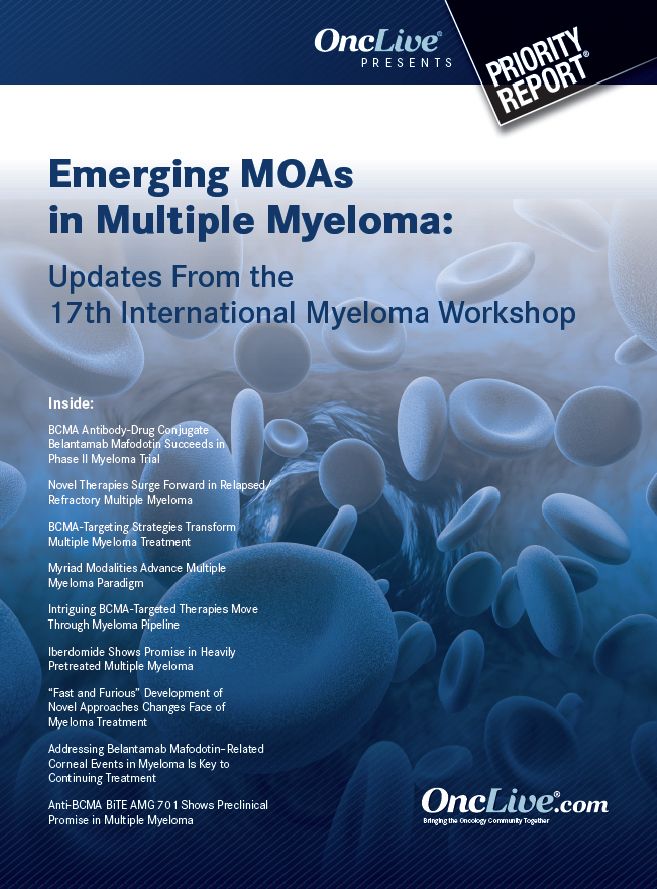Publication
Article
Special Issues
BCMA-Targeting Strategies Transform Multiple Myeloma Treatment
Author(s):
Saad Z. Usmani, MD, FACP, discusses various induction regimens and what they mean for patients with multiple myeloma.
Saad Z. Usmani, MD, FACP, chief of the Plasma Cell Disorders Program and director of clinical research in hematologic malignancies at Levine Cancer Institute

Saad Z. Usmani, MD, FACP
The development of monoclonal antibody—based therapies is changing the landscape of multiple myeloma, said Saad Z. Usmani, MD, FACP, in the form of various BCMA-targeting modalities.
“As a target, BCMA is being evaluated in different immunotherapeutic approaches, mostly in the relapsed/ refractory setting,” said Usmani. “We are hoping some of those modalities are going to be moved up to earlier lines of treatment, especially in the context of high-risk patients.”
One of these approaches includes antibody-drug conjugates (ADCs). For example, GlaxoSmithKline announced that its ADC belantamab mafodotin (GSK2857916) showed a clinically meaningful overall response rate (ORR) in patients with relapsed/refractory multiple myeloma, meeting the primary end point of the phase II DREAMM-2 trial.1 In the earlier DREAMM-1 study of the therapy, the ORR was 60% and included 3 complete responses (CRs) and 2 stringent CRs.2
In an interview with OncLive® at the 17th International Myeloma Workshop, Usmani, chief of the Plasma Cell Disorders Program and director of clinical research in hematologic malignancies at Levine Cancer Institute/ Atrium Health and clinical professor of medicine at University of North Carolina at Chapel Hill School of Medicine, discussed various induction regimens and what they mean for patients with multiple myeloma.
OncLive®: How is BCMA changing the landscape of multiple myeloma?
Usmani: BCMA is a surface marker that is highly expressed on plasma cells; it is probably a more specific marker than some of the others that have been evaluated in myeloma.
Despite the introduction of SLAMF7 and CD38-directed strategies, we recognize that we still have patients who progress through those therapies; therefore, BCMA appears to be a very lucrative target. Many different modalities that target BCMA are being evaluated in myeloma right now.
How is BCMA currently being used as a target?
First, you have the chimeric antigen receptor (CAR) T-cell strategies that we have been hearing about for over 4 years. We are moving into second- and third-generation CAR T-cell therapy trials now. CAR T cells are essentially trying to modify the patient’s own T cells to recognize the BCMA surface marker on myeloma cells. These T cells are activated and proliferate, essentially going after anything that has BCMA on the surface. The more specific target you get, the better the outcomes are for patients.
Then we have the bispecific T-cell engagers (BiTEs). AMG 420 is probably the one that’s furthest along, but there are at least 5 BiTEs targeting BCMA that we are aware of. BiTEs try to do the same thing [as CAR T cells], so one arm of the monoclonal antibody can latch onto the BCMA or any other target that they can identify. If it is BCMA specific, then it is going to target BCMA on the myeloma cell. The other arm latches onto CD3 on T cells, bringing the T cell and the myeloma cell together. Then the T cell kills the myeloma cell.
The third strategy is ADCs, where you have a BCMA-targeted antibody that has a warhead loaded onto the monoclonal antibody. Once the BCMA antibody latches onto the myeloma cell and is internalized, the toxic payload is released and kills the myeloma cell.
Each of these modalities comes with its own set of adverse events, and how quickly you can give [these agents differs]. CAR T cells have to be collected from the myeloma cell, sent to the [facility], and then manufactured. Although we are working toward shorting the manufacturing time, currently it takes around 4 weeks to get the product. Therefore, controlling a patient’s disease during that time would be a logistical issue.
Bispecifics and ADCs are off-the-shelf options. Once these products are approved and available, [clinicians will] be able to deliver the treatment as quickly as possible.
Allogeneic CAR T cells are in the works; the advantage of this approach is that if you take these cells from a healthy donor and knock off the T-cell receptor, you are essentially able to make 100 products from that donor. Those products are then sitting on the shelf, ready to go for any given patient.
CAR T-cell therapies will evolve over time, and they will eventually become an off-the-shelf option, as well, barring any safety concerns.
What is important to note about the DREAMM-1 and DREAMM-2 trials?
DREAMM-1 was a phase I study of the BCMA-directed antibody belantamab mafodotin. It showed very promising results, with, at the optimal dose of 3.4 mg/kg, almost two-thirds of the patients having a partial response or better.As a follow-up, DREAMM-2 is a randomized, phase II trial comparing a 2.5-mg/kg dose [of belantamab mafodotin] with a 3.4-mg/kg dose. The objective is to look at the safety and efficacy of these 2 doses as well as dose reductions.
One key safety issue with this particular drug was ocular and visual toxicities, which occurred in about two-thirds of patients. Most of these were reversible, but they are still a concern. Another was thrombocytopenia. As hematologists, we are not as concerned about thrombocytopenia, but it still [represents] an important day-to-day management issue for patients with myeloma.
What other investigational agents or strategies are in the pipeline?
There is [a trial of] the rapid infusion of isatuximab, which is being combined with pomalidomide (Pomalyst) and dexamethasone. We saw very good responses, north of 60%, with that combination in patients with relapsed/refractory multiple myeloma.
One goal of this trial was to see whether you can deliver isatuximab faster. The volume that we had in this part of the study was 250 mL. For the first dose of the drug, the infusions started at 25 mL/h, and it was escalated to 150 mL/h for the second dose. Then we started with 50 mL/h and escalated to 300 mL/h. Finally, the third dose was 200 mL/h from the get-go.
We were able to deliver the 90-minute infusion quite effectively in a group of 47 patients treated in this cohort. We saw greater infusion-related reactions in about 40% of patients, which is actually lower than what we saw in the first part of the study. It is doable; we can give this infusion in a shorter duration of time.
What could these findings mean for patients?
It is more of a convenience issue. Patients who do not like coming in and spending a half day in the infusion center do not have to.
Interestingly, there is another abstract that is on the same lines but with another antibody targeting CD38, daratumumab (Darzalex), which is further ahead in terms of development.
The COLUMBA study was presented at the 2019 American Society of Clinical Oncology Annual Meeting and compared intravenous (IV) daratumumab with a subcutaneous formulation of daratumumab in the newly diagnosed setting. [At the 17th International Myeloma Workshop], I reported the convenience that was part of the secondary end points of COLUMBA.
The subcutaneous formulation of daratumumab has 15 mL of volume, which can be given in under 5 minutes to patients. If you look at the IV data, formulation for the first dose takes under 7 hours, and the second dose takes about 4 hours. By the time patients are getting to the third dose on the FDA-approved label, it is another 3.5 hours. Therefore, developing the subcutaneous formulation was an important step for the patient convenience aspect.
What impact will this development have on community oncologists?
That is a very important question. From an infusion chair—occupation perspective, this will be a more convenient option for the community physicians who are always concerned about an infusion-related reaction occurring when starting IV daratumumab.
Usually, they do not have 12-hour infusion centers, as most academic centers do, so some of those nuances will be put at bay by the subcutaneous formulation. Even though we can sometimes split the first dose of daratumumab, there could be potential insurance coverage issues for the community physicians. Thus, having a subcutaneous formulation will help them out.
References
- GSK announces positive headline results from the pivotal DREAMM-2 study for multiple myeloma [news release]. London, United Kingdom: GlaxoSmithKline; August 23, 2019. bit.ly/30ul1qB.
- GSK Announces further positive data from DREAMM-1 study of anti-BCMA antibody-drug conjugate in patients with relapsed/refractory multiple myeloma [news release]. London, United Kingdom: GlaxoSmithKline; March 22, 2019. bit.ly/2TRRaZZ. Accessed March 22, 2019.










